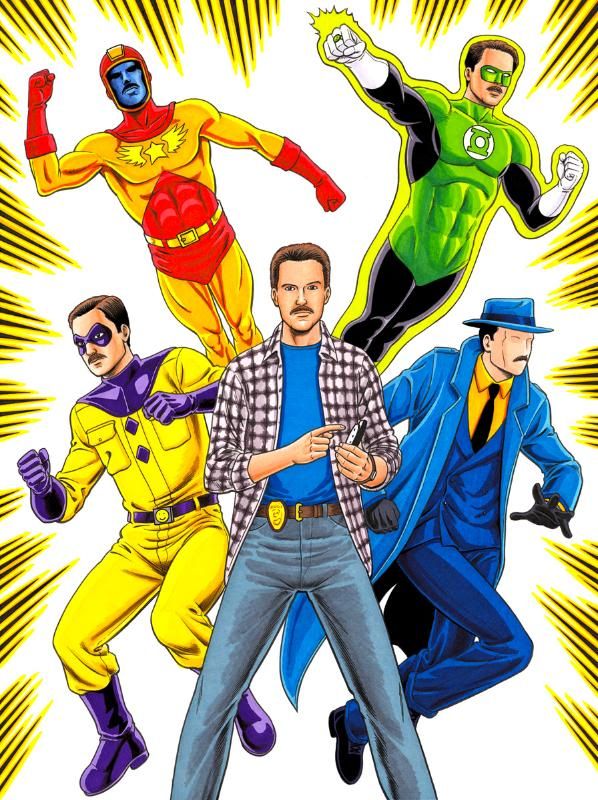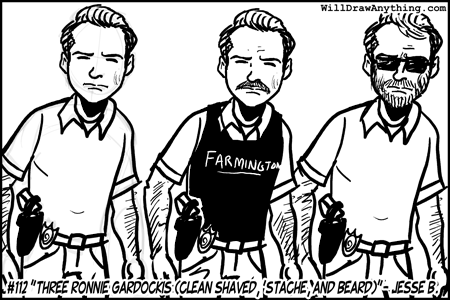Post by michaelpaciocco on Jan 30, 2009 8:14:14 GMT -8
OK, I'm going to give this a shot, and I know I'll bring the wrath of Kirk on me, but so be it. This is just my interpretation.
I think I get Final Crisis. And as flawed as it may have been, it's done more good than harm.
OK, we'll get the mundane stuff out of the way first, then move on to the more...detailed points.
First, I submit that Final Crisis >> Secret Invasion, for the following reasons:
1) Toybox Rule: Secret Invasion accomplished nothing but a "changing of the guard" and a few fatalities. Final Crisis actually brought a lot of characters back into play (and potentially more, depending on how you/other writers will interpret the ending).
2) Final Crisis had a HAPPY ENDING. Secret Invasion has lead into an even longer, more boring, GRIMDARK period.
3) Final Crisis threw in every single thing but the kitchen sink (the Fourth World! Kamandi! Tawky Tawny! OMAC! Countdown! The Freaking ZOO CREW! Sunshine Superman!). Secret Invasion had....Nick Fury? For one issue?
4) Secret Invasion was "just another event", and Final Crisis actually was something different.
OK, now, let's get onto the good and bad points. We'll get the negative out of the way first:
1) Tie-in fuckery: A flaw that FC has in common with Secret Invasion, but to a much lesser extent. Helpful tie-ins for FC that expands and helps with the story:
-Superman Beyond
-"Last Rites" (the two issue Batman arc)
-Legion of 3 Worlds (It explains why Brainiac is around in issue 6, but that's a minor detail).
Now, even with the 9 "essential" tie-in issues, it's still NOTHING compared to Secret Invasion, which would require you to pick up 14 Bendis-written Avengers issues to even fill in the gaps in the story, to say nothing of the 100 or so other tie-ins that actually give the damn thing some scope (seriously, reading the main series, you'd think the Skrulls only invaded the Savage Land and New York). At the same time, those 9 issues contain a few very important points to the overall narrative.
2) Too Clever by Half: yeah, Morrison does go crazy with gimmicks and his particular strange methods (i.e. the bullet, which as far as I can tell, actually ends up in a Moebius loop). It does tend to rip you out of the story to address the more meta issues...
3) Meta-Issues: You either like and appreciate the meta-levels or you don't. Lots didn't. That's a personal taste.
4) Short Changing: Some characters really don't get their moment in the sun at the expense of some Morrison faves. Wonder Woman in particular. Although there are some attempts to address that.
5) The Monitors: Ugh. OK, I actually get the meta level of the Monitors (I think), but still. Ugh.
Now, the good:
1) The Observer Principle brought to comics: That's really the heart of Grant's gimmick here; this is a comic wherein what you bring in and interpret influences how it ends for you. Whether it is what happens "between the panels" or how it ends. And because of that a lot of doors are open for future writers; some good, some bad, some...just different.
2) Earth-51 aka Earth Kirby: Final Crisis manages to be both a love letter to Jack's work and a complete tear down at the same time; because while Grant uses the New Gods in a fundamentally new way, he also uses it to move them off the table. Now, I kind of view this as a GOOD thing; let's wait another 10 years for the next Walt Simonson "ORION" run or something of actual value. Also, I like the idea that Earth-51 is going to be populated by nothing but Kirby concepts (Kamandi, OMACs, and The New Gods).
3) The Sequence of Important Events, as I understand it;
a) Ragnarok of the New Gods - physically destroyed, moved to earth, inhabitation of bodies.
b) Death of Orion, the Last New God, by the timetravelling Radion Bullet.
c) Rise of Darkseid and the Anti-Life Equation
d) Resistance rises
e) Batman escapes captivity - shoots Darkseid. The bullet will then travel to Kill Orion, and will then be found to be shot at Darkseid. This not only works in the context of the Fourth World Prophecy, but it also kind of highlights Orion: even dead, he turns the weapon of his enemy into the doom of his enemy. Batman is given the Omega Sanction - travels to Earth-51. At this point, Darkseid's ability to possess and destroy is weakening, slowly removing his hold on physical reality.
f) Superman Arrives, struggles with Darkseid.
g) Wonder Woman is freed (via a combination of her own resistance and Frankenstein). She then uses her lasso to remove the Anti-Life Equation and Darkseid's presence from 3 Billion People. Let me repeat that: Wonder Woman saved the lives of THREE BILLION PEOPLE. IN ONE PANEL. Which does help redeem her otherwise poor treatment in FC. Darkseid now exists on the entirely conceptual level.
h) the Survivors gather on the final Watchtower: Put "Their story" into a rocket, which then ends up on Earth-51 (which explains why in Kamandi, there's a Superman uniform, for example).
i) Superman converts all the resources remaining (with assistance from Luthor, Sivanna, etc.) into creating the Miracle Machine he saw in the 31st century to restore reality. In the process, he uses his newfound understanding of how the machine works to remove the final bits of Darkseid-as-concept.
j) Mandrakk and his vampire Ultraman shows up to foil the last attempts at restoring reality.
k) The Calvary shows up, BIG TIME.
l) Reality restored - Kirby concepts off to Earth-51, and what is fixed, is fixed. Superman wishes for a happy ending and gets one.
m) This includes the Monitors.
4) The Meta. OK, here's how I understand it:
a) FC starts out fairly linearly and comprehensible, but as Darkseid's influence grows and corrupts, the very cohesion of story breaks down because of his corruptive influence, which is why the story gets continually more and more disjointed until Superman restores it.
b) The Monitors: Are stand-ins for some of the worst impulses of the fans; obsessed with preserving the details and tiny cohesive structures, but not wanting to grow into more, until corrupted by a vampiric need to feed off the stories themselves (as represented by Mandrakk). But there is still good in us, when we go past a need to just preserve and go to a need to act and do something to improve (as represented by Nix Uotan), and are rewarded by becoming not just observers but participants.
5) What's new in the toybox (Or Old that has been brought back):
a)Transdimensional Supermen - including SuperObama, Sunshine Superman, a non-crap version of Captain Marvel, and a few dozen others worthy of exploring
b) Original Aquaman (Depending on how writers choose to go with it; I suspect there will be a good run to grab onto it).
c) The Zoo Crew - hey, if that's your thing, well, good for you!
d) Martian Manhunter - Superman wished for "a happy ending for everyone", so the door is wide open for him to come back (and hopefully with 'classic' look).
e) Anyone else - really, it is that open.
I think I get Final Crisis. And as flawed as it may have been, it's done more good than harm.
OK, we'll get the mundane stuff out of the way first, then move on to the more...detailed points.
First, I submit that Final Crisis >> Secret Invasion, for the following reasons:
1) Toybox Rule: Secret Invasion accomplished nothing but a "changing of the guard" and a few fatalities. Final Crisis actually brought a lot of characters back into play (and potentially more, depending on how you/other writers will interpret the ending).
2) Final Crisis had a HAPPY ENDING. Secret Invasion has lead into an even longer, more boring, GRIMDARK period.
3) Final Crisis threw in every single thing but the kitchen sink (the Fourth World! Kamandi! Tawky Tawny! OMAC! Countdown! The Freaking ZOO CREW! Sunshine Superman!). Secret Invasion had....Nick Fury? For one issue?
4) Secret Invasion was "just another event", and Final Crisis actually was something different.
OK, now, let's get onto the good and bad points. We'll get the negative out of the way first:
1) Tie-in fuckery: A flaw that FC has in common with Secret Invasion, but to a much lesser extent. Helpful tie-ins for FC that expands and helps with the story:
-Superman Beyond
-"Last Rites" (the two issue Batman arc)
-Legion of 3 Worlds (It explains why Brainiac is around in issue 6, but that's a minor detail).
Now, even with the 9 "essential" tie-in issues, it's still NOTHING compared to Secret Invasion, which would require you to pick up 14 Bendis-written Avengers issues to even fill in the gaps in the story, to say nothing of the 100 or so other tie-ins that actually give the damn thing some scope (seriously, reading the main series, you'd think the Skrulls only invaded the Savage Land and New York). At the same time, those 9 issues contain a few very important points to the overall narrative.
2) Too Clever by Half: yeah, Morrison does go crazy with gimmicks and his particular strange methods (i.e. the bullet, which as far as I can tell, actually ends up in a Moebius loop). It does tend to rip you out of the story to address the more meta issues...
3) Meta-Issues: You either like and appreciate the meta-levels or you don't. Lots didn't. That's a personal taste.
4) Short Changing: Some characters really don't get their moment in the sun at the expense of some Morrison faves. Wonder Woman in particular. Although there are some attempts to address that.
5) The Monitors: Ugh. OK, I actually get the meta level of the Monitors (I think), but still. Ugh.
Now, the good:
1) The Observer Principle brought to comics: That's really the heart of Grant's gimmick here; this is a comic wherein what you bring in and interpret influences how it ends for you. Whether it is what happens "between the panels" or how it ends. And because of that a lot of doors are open for future writers; some good, some bad, some...just different.
2) Earth-51 aka Earth Kirby: Final Crisis manages to be both a love letter to Jack's work and a complete tear down at the same time; because while Grant uses the New Gods in a fundamentally new way, he also uses it to move them off the table. Now, I kind of view this as a GOOD thing; let's wait another 10 years for the next Walt Simonson "ORION" run or something of actual value. Also, I like the idea that Earth-51 is going to be populated by nothing but Kirby concepts (Kamandi, OMACs, and The New Gods).
3) The Sequence of Important Events, as I understand it;
a) Ragnarok of the New Gods - physically destroyed, moved to earth, inhabitation of bodies.
b) Death of Orion, the Last New God, by the timetravelling Radion Bullet.
c) Rise of Darkseid and the Anti-Life Equation
d) Resistance rises
e) Batman escapes captivity - shoots Darkseid. The bullet will then travel to Kill Orion, and will then be found to be shot at Darkseid. This not only works in the context of the Fourth World Prophecy, but it also kind of highlights Orion: even dead, he turns the weapon of his enemy into the doom of his enemy. Batman is given the Omega Sanction - travels to Earth-51. At this point, Darkseid's ability to possess and destroy is weakening, slowly removing his hold on physical reality.
f) Superman Arrives, struggles with Darkseid.
g) Wonder Woman is freed (via a combination of her own resistance and Frankenstein). She then uses her lasso to remove the Anti-Life Equation and Darkseid's presence from 3 Billion People. Let me repeat that: Wonder Woman saved the lives of THREE BILLION PEOPLE. IN ONE PANEL. Which does help redeem her otherwise poor treatment in FC. Darkseid now exists on the entirely conceptual level.
h) the Survivors gather on the final Watchtower: Put "Their story" into a rocket, which then ends up on Earth-51 (which explains why in Kamandi, there's a Superman uniform, for example).
i) Superman converts all the resources remaining (with assistance from Luthor, Sivanna, etc.) into creating the Miracle Machine he saw in the 31st century to restore reality. In the process, he uses his newfound understanding of how the machine works to remove the final bits of Darkseid-as-concept.
j) Mandrakk and his vampire Ultraman shows up to foil the last attempts at restoring reality.
k) The Calvary shows up, BIG TIME.
l) Reality restored - Kirby concepts off to Earth-51, and what is fixed, is fixed. Superman wishes for a happy ending and gets one.
m) This includes the Monitors.
4) The Meta. OK, here's how I understand it:
a) FC starts out fairly linearly and comprehensible, but as Darkseid's influence grows and corrupts, the very cohesion of story breaks down because of his corruptive influence, which is why the story gets continually more and more disjointed until Superman restores it.
b) The Monitors: Are stand-ins for some of the worst impulses of the fans; obsessed with preserving the details and tiny cohesive structures, but not wanting to grow into more, until corrupted by a vampiric need to feed off the stories themselves (as represented by Mandrakk). But there is still good in us, when we go past a need to just preserve and go to a need to act and do something to improve (as represented by Nix Uotan), and are rewarded by becoming not just observers but participants.
5) What's new in the toybox (Or Old that has been brought back):
a)Transdimensional Supermen - including SuperObama, Sunshine Superman, a non-crap version of Captain Marvel, and a few dozen others worthy of exploring
b) Original Aquaman (Depending on how writers choose to go with it; I suspect there will be a good run to grab onto it).
c) The Zoo Crew - hey, if that's your thing, well, good for you!
d) Martian Manhunter - Superman wished for "a happy ending for everyone", so the door is wide open for him to come back (and hopefully with 'classic' look).
e) Anyone else - really, it is that open.







